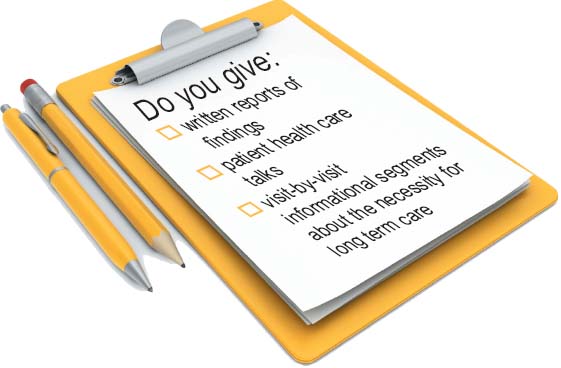Double Your Practice Without Leaving Your Front Door
by Dr. Mark Studin DC, FASBE, DAAPM, DAAMLP
Over the years as a practice consultant, I always get the same question: “How can I get more new patients?” This seems to the mantra of the masses! This seems to be the only or best way to build a practice for most.
There are numerous issues that must be addressed before an answer to this question can be rendered. What is your volume, your patient visit average (PVA), practice mix of personal injury patients, cash, managed care, workers’ compensation, and Medicare patients?
This question is followed by, “What is your office visit average (OVA) and your cost per patient to walk in the door?”
Once these statistics are analyzed, which usually takes about five seconds for someone who understands practices, recent national survey results indicate that the initial problem in most offices is that the PVA is much too low.
Thirty years ago, chiropractors built their practices around educating their patients and getting them to understand the necessity of regular care to make the spinal correction and for the body to have time to heal itself in a subluxation model. It was at that time that the “straight-mixer” debate was in full bloom. This argument was and is the “proverbial gun” that has shot chiropractic in the feet, dividing our profession. And it is about nonsense.
There is one thing we can all agree on and that is our basis of existence, and that is the adjustment to correct subluxation. How you choose to apply that is your choice. We can all agree that our goal is to first reduce the inflammation or nerve pressure to reduce pain, make a structural correction and make sure that the instabilities do not return. It’s really that simple and that is the message we need to tell our patients. If you practice in a subluxation model, you will be discussing the “Merit Chart” with your patients and the effects of subluxation on the body as a whole and, if you are a structural based practitioner, you will be discussing how to maintain that correction.
Guess what? Either way, you end up in the same place and, frankly, I don’t care how you get there!
Now the real problem. This model is a very big secret to most of your patients. Do you give written reports of findings, patient health care talks, and visit-by-visit informational segments about the necessity for long term care? Does your staff make appointments for a month at a time to lock that patient into the requisite number of visits to make that spinal correction?
If your PVA (approximate) is:
 < 25: Failed pain practice
< 25: Failed pain practice
25-35: Successful pain practice
35-50: Corrective practice
50-60: Structural stability practice
60+: Wellness practice
Once your PVA is above 25, you get to choose what type of practice you want. There is no right or wrong. However, it is much more stressful to work with a lower PVA, as the lower the PVA, the more new patients the practice requires to survive.
What takes more energy and time, acquiring, processing, and spending time with a new patient or taking an existing patient from 20 to 40 in your PVA? The answer is obvious. Take your existing patients from 20 to 40 in PVA. The byproduct is that you will not only double your numbers in volume and ensuing income, but your patients will have a greater personal connection with you and feel a whole lot better. The result, they will refer you more new patients than you could get on your own, and this takes very little energy on your part.
Your job is to educate, educate, educate. I urgently suggest you purchase a patient report of finding video, followed by a written report of findings. There are numerous good products to choose from. My mentor treated 300 patients per day and built his practice on lay lectures and written reports of finding. He was no different than you or I, he was just more focused on the goal line and educating everyone that he came in contact with.
Once you get your PVA where you want it to be, the next goal is to analyze your income sources and determine if your profitability is where you want it to be. You might decide to focus on more personal injury or workers compensation patients or move into a pure cash model. The choice is yours. However, if you are going to move into a trauma-related model, you need to ensure that your clinical skills meet the needs of your potential new patients.
Do not be naïve and think that all patients are triaged alike. You need to have the clinical skills and credentials to be successful both in patient care and in the medical-legal world. Your adjusting technique will not be the issue. It’s how to triage the patient and technology has given our profession so many new tools that the “trauma” based doctor needs to stay current on.
I spend a good portion of my day working with doctors nationally who have made the commitment towards excellence and that hard work always pays off in better results and many more new patients. There is no short cut to success in treating the trauma case.
If you want to double your practice, start by doubling your PVA through education. You are in full control of your practice and its success; all it takes is long days and sleepless nights in effort and being the best-of-the-best in everything you do.
Dr. Mark Studin is the President of CMCSManagement which offers the Lawyers Marketing Program, Family/MD Marketing Program and Compliance Auditing services. He can be contacted at www.TeachChiros.com or call 1-631-786-4253.
Program, Family/MD Marketing Program and Compliance Auditing services. He can be contacted at www.TeachChiros.com or call 1-631-786-4253.
